Voestalpine Bundle
Who Really Owns Voestalpine?
Delving into the Voestalpine SWOT Analysis reveals more than just its strengths and weaknesses; it uncovers the pivotal question of its ownership. Understanding the
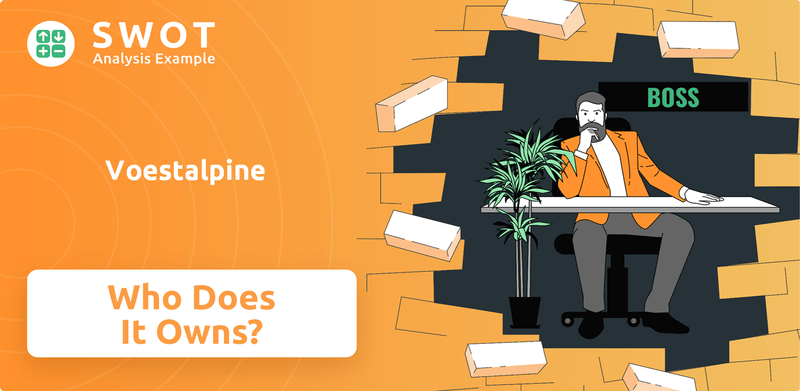
The
Who Founded Voestalpine?
The story of Voestalpine's ownership begins after World War II, emerging from the nationalized Austrian industry. Originally known as VÖEST (Vereinigte Österreichische Eisen- und Stahlwerke), the company started as a state-owned enterprise in 1946.
This means the initial ownership of the Voestalpine company was entirely with the Republic of Austria. There were no individual founders in the traditional sense, with equity splits or shareholdings at the beginning, as it was a nationalized entity. The Austrian state and, by extension, Austrian taxpayers were the early backers.
This state ownership played a crucial role in shaping its early development, focusing on post-war reconstruction and building a strong national steel industry. The company's structure was determined by government policy and the appointed management.
Voestalpine's roots are in the nationalized Austrian industry after World War II.
The company was established as a state-owned enterprise, with ownership entirely with the Republic of Austria.
There were no individual 'founders' with equity or shareholdings at the beginning.
Early development was focused on post-war reconstruction and building a strong national steel industry.
Control and strategic direction were determined by government policy and appointed management.
The vision was to rebuild and expand Austria's industrial capacity, with VÖEST playing a central role.
The initial Voestalpine ownership structure was straightforward: the Austrian state. The company's early focus was on providing essential steel products. The early management, under state guidance, aimed to rebuild and expand Austria's industrial capacity. This state-controlled beginning laid the foundation for its eventual privatization and the diversification of its Voestalpine shareholders structure. For further insights into the company's strategic positioning, consider reading about the Target Market of Voestalpine.
- The Austrian state was the sole owner.
- The focus was on post-war reconstruction.
- Management followed government policy.
- No individual founders or private shareholders existed initially.
Voestalpine SWOT Analysis
- Complete SWOT Breakdown
- Fully Customizable
- Editable in Excel & Word
- Professional Formatting
- Investor-Ready Format
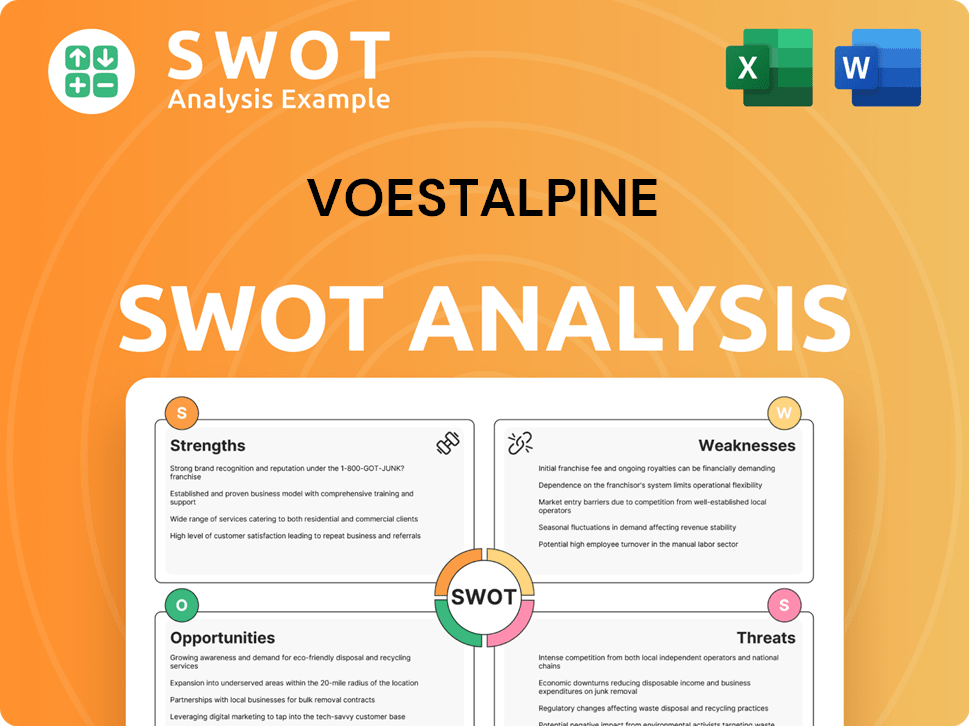
How Has Voestalpine’s Ownership Changed Over Time?
The Voestalpine ownership structure has evolved significantly since its inception. Initially under complete state ownership, the company, then known as VÖEST, underwent a gradual privatization process starting in the early 1990s. This transformation culminated in the rebranding to Voestalpine AG and its Initial Public Offering (IPO), which marked a pivotal shift towards a publicly traded company with a diversified shareholder base. This transition introduced a broader range of investors and set the stage for its current ownership dynamics.
The privatization of Voestalpine was a critical event in its Voestalpine history, reshaping its financial landscape and strategic direction. The IPO and subsequent share offerings allowed the company to raise capital, expand its operations, and adapt to the changing global market. The shift from state control to a publicly traded entity also increased transparency and accountability, influencing how the company is managed and how decisions are made.
| Event | Impact | Year |
|---|---|---|
| Initial State Ownership | Complete government control | Pre-1990s |
| Privatization Begins | Gradual transition to private ownership | Early 1990s |
| IPO | Introduction of public shareholders and increased capital | Mid-1990s (specific date varies) |
As of the fiscal year 2023/2024, the Voestalpine company is characterized by a mix of strategic core shareholders and a substantial free float. The Voestalpine shareholders include the Raiffeisenlandesbank Oberösterreich (RLB OÖ) Group, which holds a significant stake. The voestalpine Mitarbeiterbeteiligung Privatstiftung (Employee Shareholding Private Foundation) also represents a key component of the ownership, reflecting employee participation. The remaining shares are part of the free float, held by institutional investors, mutual funds, and individual shareholders worldwide. Institutional investors from countries like the UK, USA, and Germany hold considerable portions of the free float, influencing the company's strategy and market liquidity. Detailed information on institutional holdings can be found in the company's annual reports and SEC filings.
The ownership structure of Voestalpine has evolved from state control to a publicly traded model.
- Raiffeisenlandesbank Oberösterreich (RLB OÖ) Group is a major shareholder.
- Employee Shareholding Private Foundation represents significant employee ownership.
- Institutional investors from various countries hold a substantial portion of the free float.
- The company's financial reports provide detailed breakdowns of institutional holdings.
Voestalpine PESTLE Analysis
- Covers All 6 PESTLE Categories
- No Research Needed – Save Hours of Work
- Built by Experts, Trusted by Consultants
- Instant Download, Ready to Use
- 100% Editable, Fully Customizable
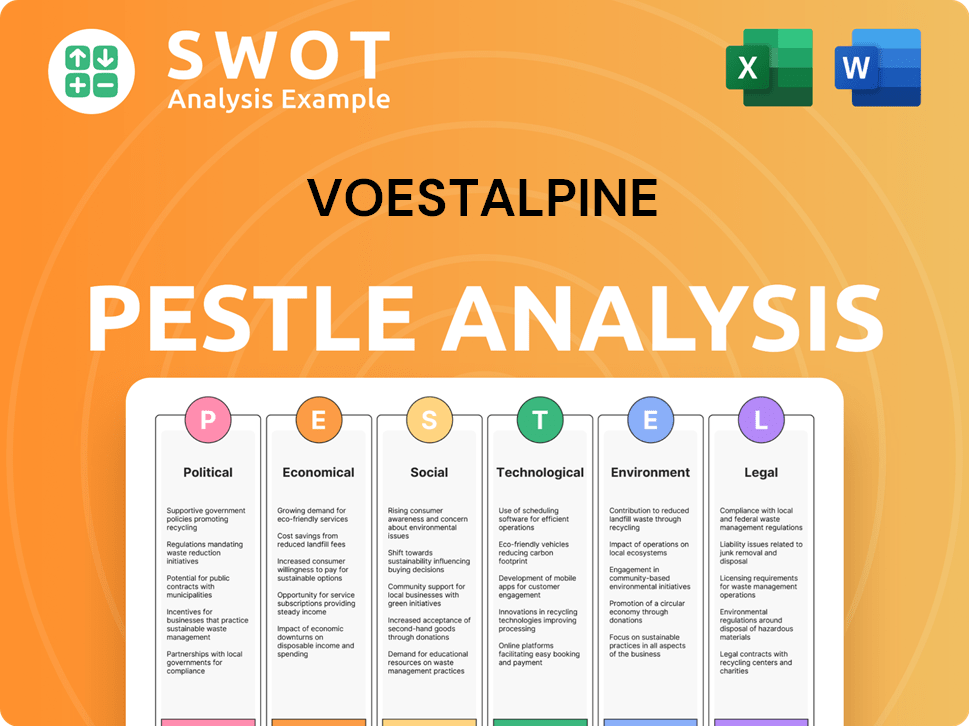
Who Sits on Voestalpine’s Board?
The Board of Directors of Voestalpine AG, also known as the Supervisory Board, oversees the Management Board and plays a key role in the company's governance. This board is composed of members representing major shareholders, employees, and independent experts. The composition reflects a balance of interests, ensuring strategic oversight and operational guidance. Key shareholders, such as the Raiffeisenlandesbank Oberösterreich Group and the voestalpine Mitarbeiterbeteiligung Privatstiftung, often have representatives on the Supervisory Board to safeguard their strategic interests. Employee representatives, elected by the workforce, also hold seats, in line with Austria's co-determination laws. Independent members provide objective oversight and expertise.
The current structure of the Supervisory Board ensures that major strategic decisions, including significant investments, acquisitions, and dividend policies, require broad shareholder consensus. The voting structure is generally based on the one-share-one-vote principle for its ordinary shares, ensuring that voting power is proportionate to shareholding. This approach helps maintain transparency and accountability in the Voestalpine company's decision-making processes. The influence of major shareholders is consistently exercised through their representation on the Supervisory Board and their voting at the Annual General Meeting.
| Board Member | Role | Affiliation |
|---|---|---|
| Wolfgang Eder | Chairman | Raiffeisenlandesbank Oberösterreich Group |
| Robert Machtlinger | Deputy Chairman | Employee Representative |
| Hannes Androsch | Member | Independent |
The voting power in Voestalpine AG is generally proportionate to shareholding, with no indications of dual-class shares or other arrangements granting disproportionate voting rights. This structure ensures that major strategic decisions require broad shareholder consensus, particularly from core shareholders. For detailed insights into the company's approach to the market, you can check out the Marketing Strategy of Voestalpine.
The Voestalpine ownership structure balances shareholder, employee, and independent interests. The Supervisory Board, representing major Voestalpine shareholders, oversees the company. Voting power is primarily based on the one-share-one-vote principle.
- The Supervisory Board includes representatives from key shareholders.
- Employee representatives ensure workforce interests are considered.
- Independent members provide objective oversight.
- Major decisions require broad shareholder consensus.
Voestalpine Business Model Canvas
- Complete 9-Block Business Model Canvas
- Effortlessly Communicate Your Business Strategy
- Investor-Ready BMC Format
- 100% Editable and Customizable
- Clear and Structured Layout
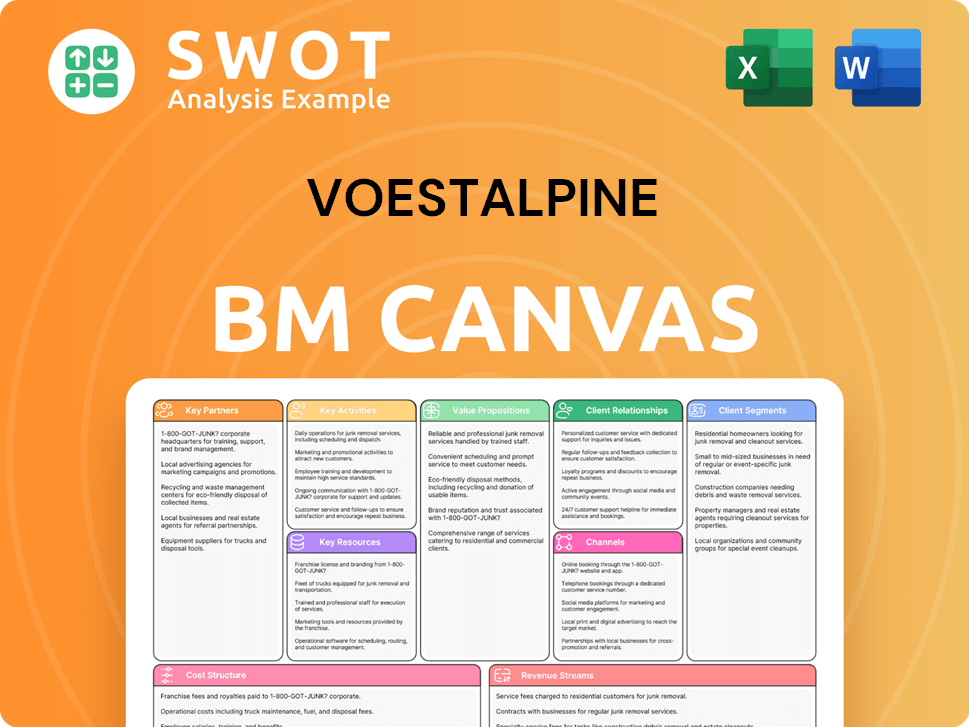
What Recent Changes Have Shaped Voestalpine’s Ownership Landscape?
Over the past three to five years, the Voestalpine ownership structure has remained largely consistent. The core shareholder base has shown stability, with institutional investors continuing to hold significant positions. The company has prioritized strategic investments and operational improvements, rather than major shifts in its ownership profile, such as large share buybacks. For instance, in fiscal year 2023/2024, Voestalpine AG focused on expanding its high-performance steel and technology segments. This indicates a commitment to long-term value creation, reflecting the company's strategy.
Industry trends, particularly the growing emphasis on ESG (Environmental, Social, and Governance) factors, have influenced the investment landscape. Voestalpine has responded by implementing initiatives focused on decarbonization and sustainable production. This approach aims to attract and retain investors who prioritize ESG considerations. Furthermore, Voestalpine's investor relations actively work to maintain a stable and supportive shareholder base. The company's public statements consistently emphasize value creation for shareholders, with no current indications of a change in its public listing status. The focus remains on strengthening its market position and operational efficiency within the existing ownership framework.
| Metric | Value (as of 2024) | Source |
|---|---|---|
| Market Capitalization | Approximately €7.5 billion | Financial reports |
| Free Float | Around 60% | Company filings |
| Number of Shareholders | Over 100,000 | Voestalpine Investor Relations |
Voestalpine's commitment to its shareholders is evident in its operational strategies and financial performance. The company's focus on innovation and sustainability aligns with the long-term interests of its investors, as detailed in Revenue Streams & Business Model of Voestalpine. This strategic direction helps maintain a stable Voestalpine company structure.
Stability in core shareholder base. Focus on ESG initiatives. Commitment to long-term value creation.
Active management to support shareholder base. Regular communication through annual reports. Transparent financial reporting.
Investments in high-performance steel and technology. Operational efficiency improvements. Expansion in key markets.
Continued emphasis on sustainable practices. Maintaining a strong market position. No planned privatization.
Voestalpine Porter's Five Forces Analysis
- Covers All 5 Competitive Forces in Detail
- Structured for Consultants, Students, and Founders
- 100% Editable in Microsoft Word & Excel
- Instant Digital Download – Use Immediately
- Compatible with Mac & PC – Fully Unlocked
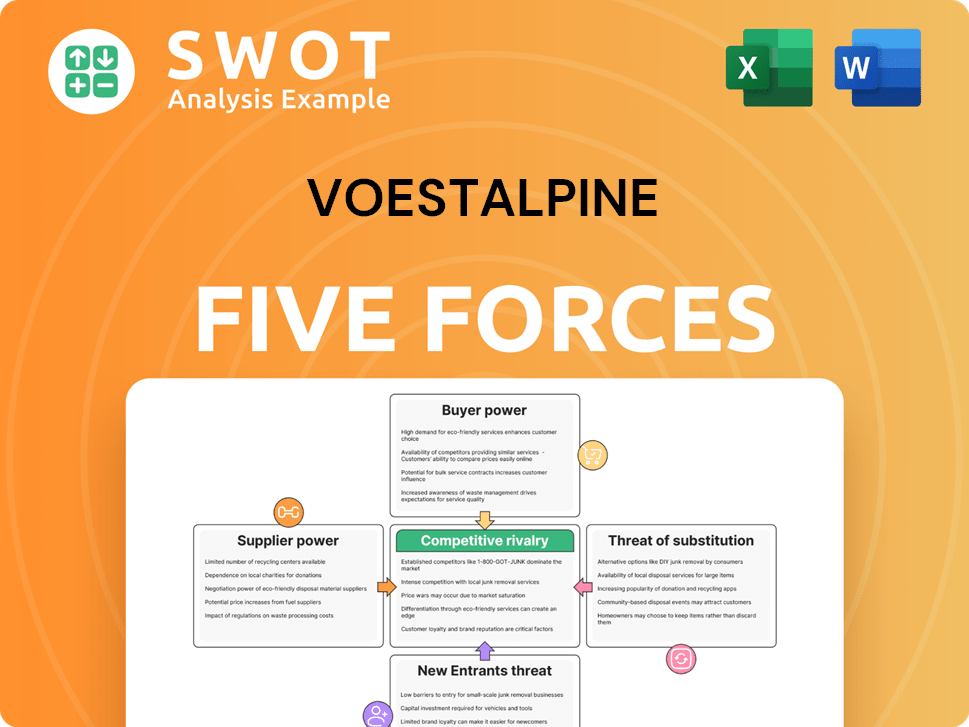
Related Blogs
- What are Mission Vision & Core Values of Voestalpine Company?
- What is Competitive Landscape of Voestalpine Company?
- What is Growth Strategy and Future Prospects of Voestalpine Company?
- How Does Voestalpine Company Work?
- What is Sales and Marketing Strategy of Voestalpine Company?
- What is Brief History of Voestalpine Company?
- What is Customer Demographics and Target Market of Voestalpine Company?
Disclaimer
All information, articles, and product details provided on this website are for general informational and educational purposes only. We do not claim any ownership over, nor do we intend to infringe upon, any trademarks, copyrights, logos, brand names, or other intellectual property mentioned or depicted on this site. Such intellectual property remains the property of its respective owners, and any references here are made solely for identification or informational purposes, without implying any affiliation, endorsement, or partnership.
We make no representations or warranties, express or implied, regarding the accuracy, completeness, or suitability of any content or products presented. Nothing on this website should be construed as legal, tax, investment, financial, medical, or other professional advice. In addition, no part of this site—including articles or product references—constitutes a solicitation, recommendation, endorsement, advertisement, or offer to buy or sell any securities, franchises, or other financial instruments, particularly in jurisdictions where such activity would be unlawful.
All content is of a general nature and may not address the specific circumstances of any individual or entity. It is not a substitute for professional advice or services. Any actions you take based on the information provided here are strictly at your own risk. You accept full responsibility for any decisions or outcomes arising from your use of this website and agree to release us from any liability in connection with your use of, or reliance upon, the content or products found herein.